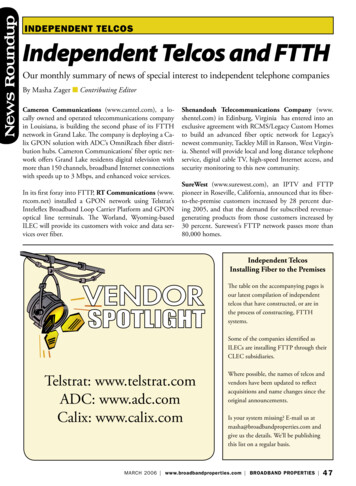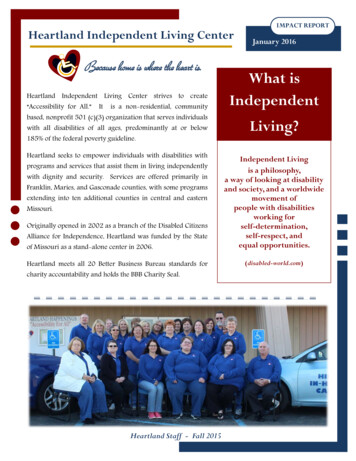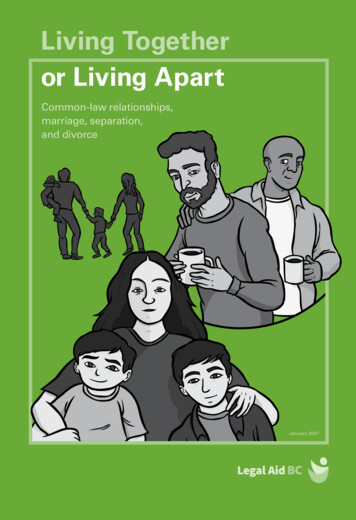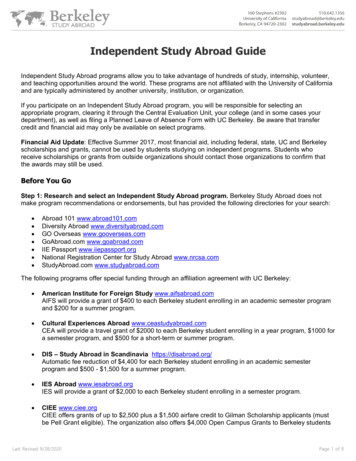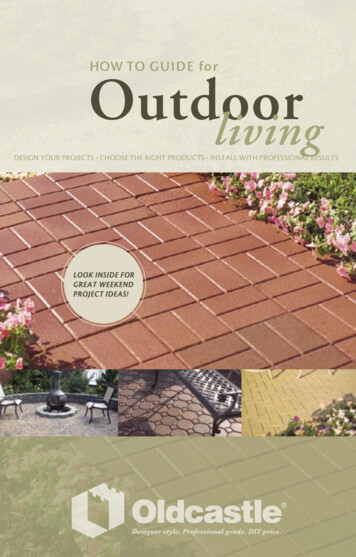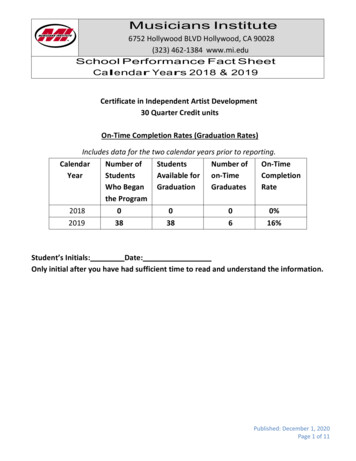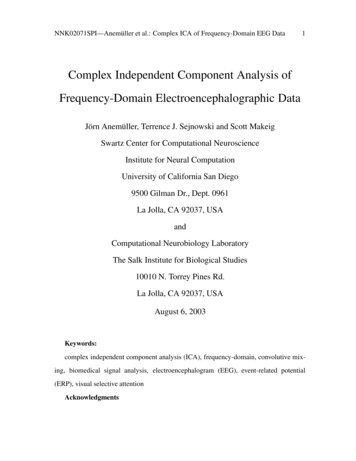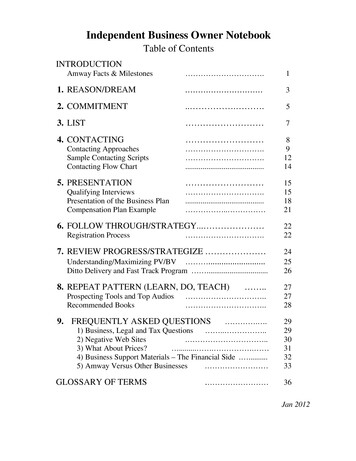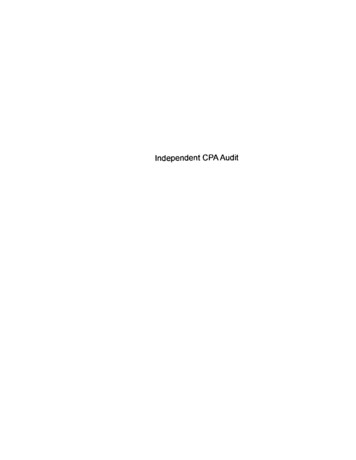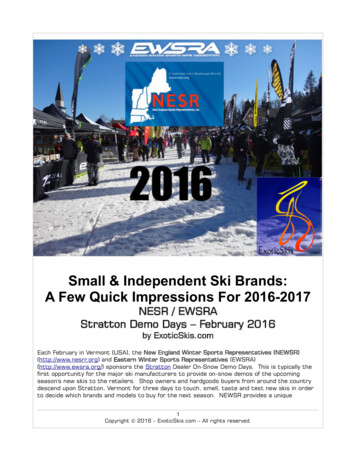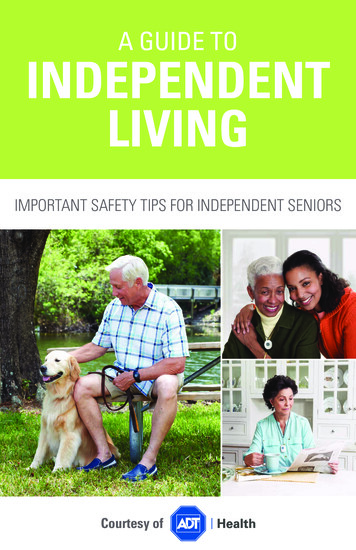
Transcription
A GUIDE TOINDEPENDENTLIVINGIMPORTANT SAFETY TIPS FOR INDEPENDENT SENIORSCourtesy of
“ INDEPENDENT LIVINGMATTERS „TO ME AND MY LOVED ONES.1
LET’S GET MOVING TOWARD MOREINDEPENDENCE.Today, more and more seniors are enjoying their independence longer.Through a balance of exercise and healthy eating, they’re able to leadvery active lifestyles. Healthy living isn’t just about diet and exercise,though. It includes keeping a safe home, maintaining a healthy mind,and improving your overall wellness. We hope this guide is helpfuland makes healthy living easy and fun.For over 140 years, ADT, America’s #1 security company, has helpedprovide peace of mind to over 6 million customers, caregivers andfamily members. We look forward to doing the same for you.2
GETTING ACTIVE,GETTING BETTERAn important part of independent living is making sure you’re ableto take care of yourself at home. A great way to achieve that goal isto stay active and exercise regularly. Simple activities such as takinga stroll around the neighborhood or doing some light yard work canhelp you stay stronger and healthier longer. In fact, small amountsof exercise can help prevent falls by building and maintaining yourstrength and balance.BENEFITS OF EXERCISEOnce you start exercising on a regular basis, you may notice:Daily tasks become easierYou have more energyYou’re getting in shape and maintaining or losing weightYour breathing is improvingYou’re getting stronger and may have better balanceYou’re feeling better physically You’re able to manage and slow down the progressionof diseases like diabetes, heart disease and osteoporosis3Your mood is improvingYou’re sleeping better
ENJOY EXERCISE SAFELYOne of the goals of physical activity is to decrease the possibility ofinjuring yourself. So make sure you take it easy if you’re just startingout. Before you start exercising, remember to: Consult your physician to make sure it’s okay Start slowly Warm up and stretch Remember to breathe as you exercise Stop if you feel pain Drink plenty of fluidsQUICK TIPBe sure to warm up for a few minutes before you exercise to get yourbody ready for activity. Shrug your shoulders, tap your toes, swing yourarms or move in place.MAKE EXERCISE FUN!Almost anyone can exercise, even if you have a long-term conditionlike heart disease, diabetes or arthritis. The key to enjoying exerciseis to make sure you pick activities you like doing so it doesn’t feel likea chore. Who knows? You might even start looking forward to it. Also,don’t be afraid to try some new activities to add a little variety: Stretching Water aerobics class Dance lessons Chair exercises Exercise classes4
THE 4 BASIC KINDS OF EXERCISEACCORDING TO THE NATIONAL INSTITUTE OF HEALTHENDURANCEEndurance, or aerobic exercise, increases your breathing and heart rate.Endurance activities strengthen your heart, while improving the overallfunction of your lungs and circulatory system.Examples: Walking Swimming JoggingTRYTHISWalking—You can enjoy the health benefits of this type ofexercise even if you do it just 30 minutes a day. Be sure to walksafely: tie shoelaces tight, wear comfortable athletic shoes, walkduring dayligtht hours, and always be aware of your surroundings.BALANCEBalance exercise helps prevent falls, a common problem in older adults.Lower body strength can help with balance and body stabilization.Examples: Yoga DancingTRYTHIS Water aerobicsUpper-Body Twists—Stand with your hands on your hips and yourfeet apart. Slowly turn your upper body to the left as far as you can fora count of 5. Then to the right for a count of 5. Repeat 10 times.QUICK TIP5Make a weekly exercise and physical activity plan—this will help you incorporateall four types of exercise into your daily routine. Find an exercise plan worksheetat the Go4Life website (https://go4life.nia.nih.gov)
FLEXIBILITYFlexibility exercise stretches your muscles and helps keep your bodylimber for easier movement.Examples: Shoulder, upper arm and calf stretching YogaTRYTHISNeck Stretch—In a standing position or sitting in a chair, spread yourfeet about shoulder width apart. Slowly turn your head to the right untilyou feel a slight stretch. Try not to tilt your head. Hold the position for10-30 seconds. Slowly turn to the left side to stretch. Repeat 3-5 times.STRENGTHStrength exercise makes your muscles stronger. Stronger musclesallow you to carry out daily independent activities like climbing stairs,carrying groceries or getting up out of seats.Examples: Lifting weights Using a resistance bandTRYTHISWall Push-Ups—Stand about a foot away from a sturdy wall at home.Place your hand flat against the wall. Slowly lower your body toward thewall. Then push away until you’re in the original position. Repeat 10 times.QUICK TIPYou’re more likely to exercise if it’s convenient. Put your hand weights nextto the sofa so you can do some lifting while you watch TV.6
HEALTHY EATING FOR A BETTER YOUAccording to the National Institute on Aging, exercise and eating wellare the keys to a healthy lifestyle. A balanced, nutritious diet givesyou the energy your body needs to do whatever physical activitiesyou choose. It also can reduce the risk of heart disease, stroke, type 2diabetes and some kinds of cancer.What Does Healthy Eating Look Like? Focuses on vegetables, fruits, whole grains and fat-free or low-fat milk and dairy products Includes lean meats, poultry, fish, cooked dry beans and peas,eggs and nuts Is low in saturated fats, trans fats, salt and added sugars Balances calories from food and beverages with caloriesburned through physical activity to maintain a healthy weightQUICK TIP7For information on heart-healthy eating plans, visit the National Heart,Lung and Blood Institute (NHLBI) at www.nhlbi.nih.gov
TAKING CARE OF YOURSELF—BODY, MIND AND SPIRITIMPROVING MENTAL HEALTHStudies have shown that moderate daily physical activity can not onlyimprove physical health, but can also help manage stress and improvemood. While the benefits of physical activity on the mind have been wellestablished, what can you do to improve your brain function and mentalhealth when you’re unable to be physically active?Give Your Mind A WorkoutThe key to maintaining a strong mind is mental stimulation. Fortunately,there are all sorts of activities that can keep you engaged and your mindsharp, such as: Culinary arts Book club Volunteering andcommunity service Arts and crafts Photography Learn a foreignlanguage Board game/trivia night Crossword puzzlesQUICK TIPEvery bit of exercise can help the mind. Physical activity increasesblood flow and brain stimulation, while helping enhance brain healthin seniors.8
PREVENTING FALLSEvery year, more than 2 million older Americans go to the emergencyroom because of fall-related injuries.1 When it comes to avoiding fallsand serious injuries that can include hip and bone fractures, as wellas head trauma, prevention is the key. Exercise—Make falls less likely by utilizing the 4 differenttypes of exercise to build strength, improve balance andcontrol muscles. Eliminate Home Hazards—Inspect the home for trippinghazards or areas with poor lighting. Keep a clean, easy-tonavigate home by removing excess clutter. Try placingfrequently used items in drawers or cabinets and on shelvesthat don’t require a stepstool for access. Outfit The Home—Make sure handrails are in places nearsteps and in the bathroom. Place nonskid pads or double-sidedtape under rugs and place grip appliques or rubber mats in the shower or tub. Also, think about updating the lighting for awell-lit home. Get Vision Checked—Poor vision can lead to accidents.Older adults should get their vision checked yearly and haveaccess to their most up-to-date prescription lenses or contacts.1—National Institute on Aging9
A QUICK QUIZ:Many of the accidents that often cause falls can be prevented by a fewsafety choices. Take this quiz to see how fall-proof your home is.1 Are your outdoor walkways well-lit?2 Are your hallways and stairways well-lit and free of clutter?3 Are handrails sturdy on both sides of the stairway?4 Do you have a night-light on in the bathroom and bedroom?5 Do all your throw rugs and area rugs have nonskid backing or adhesive?6 Is your furniture sturdy and stable?7 Do you have safety handrails in the bathtub and toilet areas?8 Is there a rubber mat or nonskid strips on the bathtub/shower floor?9 Do you wear low-heeled or flat shoes with nonskid soles?10 Is there a place where you can sit while cooking or chopping vegetables?How did you do? If you answered “no” to any of these questions,visit www.nia.nih.com to learn exactly how you can make yourhome safer.10
HOW ADT MEDICAL ALERTSYSTEMS WORKHELP THAT IS ALWAYS THERE—WHENEVERYOU NEED IT.Our medical alert systems provide dependable, round-the-clockmonitoring from caring, trained ADT professionals, allowing olderadults to live worry-free, both at home and on the go.11
GET ASSISTANCE WITH 3 SIMPLE STEPS:!1In the event of an emergency, push your personal helpbutton, located on your pendant or wristband. Systemsequipped with optional Fall Detection will automaticallysend an emergency alert signal to ADT, if a fall occurs.2When the alarm signal is received at our MonitoringCenter, a trained, ADT professional can respondto the customer over the base unit’s two-way voicecommunicator. If there is no response, the operator willcall for help. 3ADT notifies emergency responders or family as needed.On-The-Go users also benefit from GPS location services.12
ADT MEDICAL ALERT SYSTEMSIN-HOME SYSTEMSON-THE-GO SYSTEM13FOR MORE INFORMATION ABOUT ADT MEDICAL ALERT SYSTEMS,SPEAK TO AN ADT HEALTH REPRESENTATIVE
AT HOME OR ON THE GO, ADT HAS A SYSTEMTO FIT YOUR LIFESTYLE.All Of Our Systems Feature: 24/7/365 monitoring from ADT professionals. Fast response time that is the push of a button away.In-Home Medical Alert Systems Easy-to-use waterproof neck pendant or wristband includesyour own personal help button. Works in virtually any room in the home, for available helpwherever you go. Optional Fall Detection alerts ADT even if the button hasn’tbeen pushed, ensuring help is notified. Status lights, including signal strength, make device easyto read.On-The-Go Emergency Response System Our mobile technology, featuring GPS location services, allowsconstant monitoring—whether you’re at home or miles from it. Connection to ADT Monitoring Center means not having tooperate a mobile phone during critical events. Portable device has a long battery life and is easy to charge. Operates with wireless connection; convenient for householdswithout a traditional phone line.800.595.8740 OR ORDER ONLINE AT ADT.COM/HEALTH.14
MORE SAFETY TIPS FORINDEPENDENT LIVING.GENERAL SAFETY TIPS Make sure to ask for ID when any service people you don’t knowcome to your home. Don’t give out personal information over the phone, through themail or on the Internet unless you know and trust the person orcompany you are dealing with. Give a neighbor or nearby relative a spare key to your house incase of an emergency. A lockbox is another good option forkey storage.15
HOME SAFETY Don’t leave notes for family or friends outside your home. Keep hallways and stairwells well-lit for easier navigationafter dark. Add non-slip mats where it’s common to find water on thefloor, like the kitchen or bathroom. Keep flashlights handy and in multiple locations. Include onenear your bed in case of a power outage.MEDICATION Create a list of your medical information including currentconditions, medications, dosages and emergency contactsand post it where it can be easily found. Bring your medical information list to doctor appointmentsand when you go to the pharmacy.CYBERSAFETY Avoid opening email or instant messages receivedunexpectedly or from people you don’t know. Be careful of providing personal information and financialinformation online unless the site is secure.16
TOGETHER, WE CAN DO THIS.We hope this guide helps get you started on your journey toward goodhealth and independent living. Remember, just 30 minutes a day ofmoderate physical activity and a healthy diet will help you stay strongerand live independent longer.No matter how independent you feel, it’s always good to know that youaren’t alone, in case of an emergency. ADT can help you find the rightMedical Alert System to fit your lifestyle.Why Choose ADT? The #1 security company in America. Helping to save lives for over 140 years through technologicalinnovation and easy-to-use products. ADT trained monitoring professionals are always available,including nights, weekends and holidays.For more information on how ADT canalways be there for you or a loved one,contact your ADT Health Representativeat 800.595.8740 or visit us on the webat ADT.com/health.17
18
All content found herein was created for informational purposes only. The content is not intended to be a substitute for professionalmedical advice, diagnosis, or treatment. Always seek the advice of your physician or other qualified health provider with anyquestions you may have. ADT does not endorse information mentioned herein, including any website referenced. Reliance on anyinformation provided herein is solely at your own risk.Source: https://go4life.nia.nih.gov/partnerAn ADT Medical Alert system (Medical Alert Basic, Medical Alert Plus and On-The-Go Emergency Response) is not an intrusiondetection system or medical device; ADT is not a ‘911’ emergency medical response service and does not provide medical advice,which should be obtained from qualified medical personnel. Fall Detection only available on Medical Alert Plus and On-The-GoEmergency Response system for 10 per month ( 120/yr). The Fall Detection pendant does not detect 100% of falls. If able, usersshould always push their help button when they need assistance. Digital cellular service not available everywhere an
Healthy living isn’t just about diet and exercise, though. It includes keeping a safe home, maintaining a healthy mind, and improving your overall wellness. We hope this guide is helpful and makes healthy living easy and fun. For over 140 years, ADT, America’s #1 security company, has helped provide peace of mind to over 6 million customers, caregivers and family members. We look forward .
